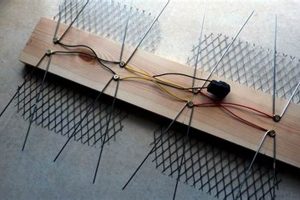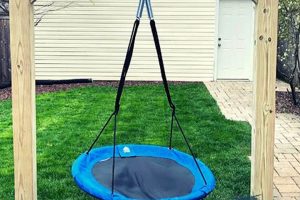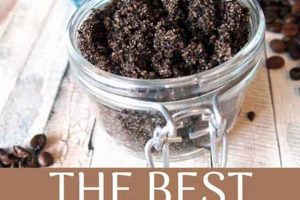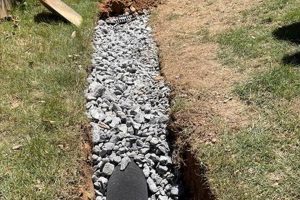A method of immersing the feet in a liquid solution prepared from household ingredients, offers a customizable approach to foot care. This practice involves combining warm water with various additives, such as salts, essential oils, and herbal infusions, to create a therapeutic treatment. As an example, Epsom salt and lavender oil can be added to warm water for relaxation and relief from muscle soreness.
This practice holds value for its potential to promote relaxation, alleviate foot pain, and soften skin. Historically, similar practices have been used in various cultures for cleansing, medicinal, and ritualistic purposes. The perceived benefits extend to improved circulation, reduced inflammation, and enhanced mood, contributing to overall well-being.
The subsequent sections will detail the ingredients commonly used, provide guidance on preparation methods, and outline safety considerations for this practice. Further information regarding specific recipes and their intended effects will also be discussed.
DIY Foot Soak
The subsequent recommendations provide guidance on maximizing the effectiveness and ensuring the safe application of homemade foot treatments.
Tip 1: Water Temperature Regulation: Maintain a water temperature between 92F (33C) and 100F (38C). Exceeding this range may lead to scalding or discomfort. Use a thermometer for accurate measurement.
Tip 2: Ingredient Quality Assessment: Employ high-quality ingredients, prioritizing those free from artificial additives and known irritants. Opt for pure essential oils and natural salts to minimize potential adverse reactions.
Tip 3: Soak Duration Management: Limit immersion time to 15-20 minutes per session. Prolonged exposure may cause skin dehydration or exacerbate existing skin conditions.
Tip 4: Hydration Protocol: Consume adequate fluids before, during, and after the treatment to counteract potential fluid loss through perspiration.
Tip 5: Post-Soak Skin Care: Thoroughly dry the feet following immersion and apply a moisturizer to retain hydration. Consider using a lotion containing emollients such as shea butter or cocoa butter.
Tip 6: Sanitation Practices: Ensure the basin used is thoroughly cleaned before and after each use to prevent bacterial or fungal contamination. Use a disinfectant to sanitize the basin surface.
Tip 7: Medical Condition Awareness: Individuals with diabetes, neuropathy, or circulatory issues should consult a healthcare professional before initiating a regular regimen. Certain ingredients may be contraindicated.
Adhering to these recommendations enhances the therapeutic benefits and mitigates potential risks associated with the practice.
The concluding section will offer a summary of the key considerations discussed and provide resources for further research.
1. Ingredient Selection
Ingredient selection forms the cornerstone of an effective foot soak, directly influencing its therapeutic benefits and overall outcome. The choice of additives significantly alters the properties of the water, determining its ability to soothe, cleanse, and revitalize the feet.
- Salts: Osmotic and Mineral Action
Salts, such as Epsom salt (magnesium sulfate), sea salt, and Himalayan pink salt, are frequently incorporated. Their osmotic properties aid in drawing out excess fluid from tissues, reducing swelling and discomfort. Epsom salt provides magnesium, a mineral believed to alleviate muscle soreness and promote relaxation. Different salt types offer varied mineral compositions, contributing to distinct therapeutic effects.
- Essential Oils: Aromatherapy and Therapeutic Properties
Essential oils introduce aromatherapy benefits and targeted therapeutic actions. Lavender oil is known for its calming and antiseptic properties, while peppermint oil can provide a cooling sensation and alleviate pain. Tea tree oil exhibits antifungal and antibacterial characteristics, suitable for addressing foot infections. The concentration and specific properties of the chosen oil dictate its effect on the skin and sensory experience.
- Acids: Exfoliation and pH Balance
Acids, such as vinegar (acetic acid) or citric acid (from lemon juice), can be added to lower the pH of the water. This acidity aids in exfoliating dead skin cells and softening calluses. Furthermore, a slightly acidic environment can inhibit the growth of certain bacteria and fungi, contributing to foot hygiene. However, caution is advised, as excessive acidity can irritate sensitive skin.
- Herbal Infusions: Anti-inflammatory and Soothing Effects
Herbal infusions, derived from dried herbs like chamomile, calendula, or rosemary, impart anti-inflammatory and soothing effects. These herbs contain compounds that can reduce inflammation, promote healing, and provide a calming aroma. The specific properties of the chosen herb determine its therapeutic action, with chamomile known for its relaxation benefits and calendula valued for its skin-healing properties.
The careful selection and combination of these ingredients allows for customization, tailoring the experience to address specific needs and preferences, thereby maximizing the potential benefits. A thoughtful approach to ingredient selection elevates the treatment from a simple soak to a targeted therapeutic intervention.
2. Water Temperature
Water temperature constitutes a critical parameter influencing the efficacy and safety of a foot immersion treatment. Deviation from the optimal range can significantly impact the intended therapeutic outcome and potentially induce adverse physiological effects. The thermal properties of water mediate several processes, including vasodilation, nerve stimulation, and cellular metabolism, all of which are relevant to the benefits sought from a foot soak.
Elevated water temperatures, exceeding approximately 105F (40C), can induce cutaneous burns, particularly in individuals with impaired peripheral sensation, such as those with diabetes or peripheral neuropathy. Conversely, water temperatures below approximately 90F (32C) may fail to elicit adequate vasodilation, thereby limiting the absorption of therapeutic compounds and diminishing the intended relaxation response. An example illustrating the importance of thermal regulation involves the use of Epsom salts. Warm water facilitates the dissolution of magnesium sulfate, allowing for its absorption through the skin. Insufficient water temperature hinders this process, reducing the potential benefits. Proper control requires the use of a thermometer to ensure the water is within the safe and effective range.
Maintaining the correct water temperature optimizes the therapeutic potential of the treatment and minimizes the risk of adverse reactions. Careful attention to
this parameter is fundamental to a safe and beneficial experience. It enables effective vasodilation, improves substance absorption, and prevents thermal injury, contributing to the intended physiological and psychological relaxation. The practical significance of understanding water temperature lies in its direct impact on the health and well-being of the individual, particularly for those with pre-existing health conditions.
3. Immersion Duration
Immersion duration serves as a critical variable in determining the efficacy and potential adverse effects associated with foot treatments. The length of time feet are exposed to the solution directly influences the extent of chemical absorption, hydration levels, and physiological responses. Prolonged immersion increases the risk of skin maceration, leading to weakened barrier function and heightened susceptibility to infection. Conversely, insufficient exposure may not allow for adequate absorption of therapeutic compounds, diminishing the intended benefits. For example, when employing Epsom salts to alleviate muscle soreness, an inadequate soak time might preclude sufficient magnesium absorption for effective relief.
An optimal immersion duration strikes a balance between maximizing therapeutic absorption and minimizing the risk of adverse dermatological effects. Typically, a duration of 15 to 20 minutes is considered appropriate for most individuals. This timeframe allows for sufficient contact between the skin and the active ingredients, facilitating their absorption into the underlying tissues. However, the ideal duration may vary based on individual factors, such as skin sensitivity, existing medical conditions, and the specific ingredients used. For instance, individuals with diabetes or peripheral neuropathy may require shorter immersion times to avoid complications associated with impaired circulation and sensation. The concentration of active ingredients also influences the appropriate duration; higher concentrations may necessitate shorter exposure to prevent irritation.
In summary, the immersion duration represents a crucial parameter that dictates the effectiveness and safety of foot soaks. Adherence to established guidelines and consideration of individual factors are essential for optimizing the treatment’s benefits while mitigating potential risks. Understanding and carefully managing the immersion duration is integral to realizing the full therapeutic potential while safeguarding cutaneous integrity.
4. Hygiene Protocols
The intersection of hygiene protocols and homemade foot treatments necessitates rigorous adherence to established sanitation practices. Insufficient attention to hygiene introduces a tangible risk of bacterial, fungal, or viral transmission, potentially transforming a therapeutic practice into a source of infection. Contaminated basins, improperly sanitized implements, or the sharing of solutions create a conducive environment for microbial proliferation, thereby undermining the intended benefits and posing a direct threat to foot health. The absence of proper hygiene can result in conditions such as athlete’s foot, nail fungus, or bacterial skin infections.
Implementation of stringent hygiene protocols is essential for mitigating these risks. Prior to each foot treatment, thorough cleansing of the basin with a suitable disinfectant, such as diluted bleach or a commercial antimicrobial solution, is imperative. All implements used, including pumice stones and nail brushes, must undergo a similar disinfection process. Individuals with pre-existing foot infections should avoid sharing solutions or equipment to prevent cross-contamination. Furthermore, diligent washing of hands both before and after the procedure minimizes the introduction and spread of microorganisms. A practical example involves the use of tea tree oil, known for its antifungal properties; however, its efficacy is negated if the treatment is performed in an unsanitized environment.
In summary, hygiene protocols constitute an indispensable component of foot treatments. The practical significance of adhering to these protocols cannot be overstated, as it directly safeguards against potential infections and preserves the therapeutic integrity. Challenges may arise in maintaining consistent adherence, particularly with repeated use; however, the consequences of neglecting hygiene far outweigh the perceived inconvenience. By prioritizing stringent hygiene practices, individuals can ensure that foot treatments remain a safe and beneficial practice, contributing to overall foot health and well-being.
5. Skin Hydration
Skin hydration constitutes a critical factor influencing the overall effectiveness and potential benefits derived from foot treatments. Immersion in water, particularly when augmented with specific additives, can profoundly impact the skin’s moisture content and barrier function. The interplay between water absorption, osmotic forces, and the inherent properties of the solution necessitates a nuanced understanding to optimize hydration levels and prevent adverse effects.
- Water Absorption and Osmotic Balance
During immersion, the skin absorbs water, increasing its hydration levels. However, the osmotic gradient between the solution and the skin can influence the direction and magnitude of water movement. Hypertonic solutions, such as those with high salt concentrations, can draw water out of the skin, leading to dehydration. Conversely, hypotonic solutions promote water absorption. Maintaining an appropriate osmotic balance is crucial for preventing excessive water loss or gain, both of which can compromise skin integrity.
- Emollients and Occlusive Agents
The incorporation of emollients, such as oils and butters, or occlusive agents, like waxes, within the solution can significantly enhance skin hydration. Emollients fill the spaces between skin cells, smoothing the surface and improving the skin’s ability to retain moisture. Occlusive agents form a protective barrier on the skin’s surface, preventing water loss through evaporation. Examples include adding olive oil or shea butter to create a hydrating effect.
- The Role of Humectants
Humectants, such as glycerin or honey, attract water from the environment and draw it into the skin. This property helps to increase the skin’s water content and maintain hydration levels. When used in these treatments, humectants can enhance the hydrating effects, particularly in dry or arid climates. However, the efficacy of humectants depends on ambient humidity; in very dry conditions, they may draw moisture from deeper layers of the skin, potentially exacerbating dehydration if not combined with occlusive agents.
- Post-Treatment Hydration Maintenance
Following treatment, diligent application of a moisturizer is essential for sealing in the hydration gained during immersion. Moisturizers containing a combination of humectants, emollients, and occlusive agents provide the most comprehensive approach to maintaining skin hydration. Failure to moisturize after the treatment can lead to rapid water loss and a return to pre-treatment hydration levels. The selection of an appropriate moisturizer should consi
der individual skin type and any specific sensitivities or allergies.
In summary, skin hydration represents a multifaceted aspect that significantly influences the therapeutic outcomes. Careful consideration of osmotic balance, the incorporation of emollients and humectants, and adherence to post-treatment moisturizing practices are essential for maximizing the benefits and maintaining skin health. Understanding these factors allows for customization of the experience, tailoring it to individual needs and preferences, thereby enhancing the overall effectiveness and preventing adverse dermatological effects.
6. Medical Contraindications
Medical contraindications represent a critical consideration when engaging in homemade foot treatments. Certain underlying health conditions can be exacerbated or negatively impacted by the immersion of feet in various solutions. Understanding these contraindications is essential to prevent adverse health outcomes. For instance, individuals diagnosed with diabetes often experience impaired peripheral circulation and reduced nerve sensation. Immersion in hot water can lead to undetected burns, while prolonged soaking can promote skin maceration and increase the risk of foot ulcers. Similarly, peripheral neuropathy, regardless of its etiology, compromises the ability to accurately perceive temperature, heightening the risk of thermal injury.
Furthermore, individuals with certain dermatological conditions, such as eczema or psoriasis, may experience exacerbations of their symptoms due to specific ingredients commonly incorporated into such foot soaks. Essential oils, salts, or other additives can act as irritants, triggering inflammatory responses and compromising the skin barrier. Real-life examples include allergic reactions to lavender oil in individuals with sensitive skin or worsening of eczema symptoms following exposure to highly concentrated salt solutions. Those with venous insufficiency or lymphedema should also exercise caution, as prolonged immersion can potentially exacerbate fluid retention and swelling. The practical significance of understanding these medical contraindications lies in the ability to personalize foot treatments, adjusting ingredient selection and immersion parameters to minimize risks and maximize benefits.
In summary, awareness of medical contraindications constitutes an indispensable element of safe and effective homemade foot care. Challenges may arise in identifying subtle symptoms or pre-existing conditions that warrant caution; however, the potential consequences of neglecting these considerations underscore the need for informed decision-making and, when necessary, consultation with a healthcare professional. A proactive approach to identifying and addressing medical contraindications is essential for ensuring that foot treatments remain a beneficial practice, contributing to overall well-being without compromising individual health.
Frequently Asked Questions Regarding DIY Foot Soaks
The following addresses common inquiries and misconceptions concerning the preparation and application of homemade foot treatments.
Question 1: Is frequent execution of treatments generally recommended, or are there potential drawbacks associated with excessive use?
Daily treatments are generally discouraged. Excessive immersion can lead to skin maceration, dehydration, and an increased susceptibility to infections. A frequency of two to three times per week is typically considered appropriate.
Question 2: What constitutes the appropriate water temperature for a treatment, and what risks are associated with deviations from this temperature?
The ideal water temperature ranges between 92F (33C) and 100F (38C). Temperatures exceeding this range can cause burns, while temperatures below may not provide adequate therapeutic benefits.
Question 3: Can treatments be utilized in cases of pre-existing medical conditions, such as diabetes or peripheral neuropathy?
Individuals with diabetes or peripheral neuropathy should exercise caution and consult a healthcare professional prior to initiating a regimen. These conditions can impair sensation and circulation, increasing the risk of complications.
Question 4: What are the potential adverse reactions associated with specific ingredients, such as essential oils or salts?
Essential oils can cause allergic reactions or skin irritation in sensitive individuals. High concentrations of salts can lead to skin dehydration. It is advisable to perform a patch test prior to full immersion to assess tolerance.
Question 5: How does immersion duration impact the efficacy and safety of foot treatments?
Prolonged immersion can lead to skin maceration and increase the risk of infection. Insufficient duration may not allow for adequate absorption of therapeutic compounds. A duration of 15 to 20 minutes is generally considered optimal.
Question 6: What hygiene measures should be implemented to minimize the risk of infection during treatments?
The basin should be thoroughly cleaned with a disinfectant before each use. Implements, such as pumice stones, should be similarly sanitized. Sharing solutions or equipment should be avoided to prevent cross-contamination.
Consistent adherence to established guidelines and an informed approach to ingredient selection are essential for maximizing the benefits and minimizing the risks associated with these practices.
The subsequent section will summarize the key considerations discussed and provide resources for further research.
DIY Foot Soak
This article has explored various facets of the subject, including ingredient selection, water temperature regulation, immersion duration, hygiene protocols, and relevant medical contraindications. The effective and safe implementation of such treatments necessitates a thorough understanding of these parameters, emphasizing the importance of informed decision-making and adherence to established guidelines. The integration of appropriate techniques and components determines therapeutic efficacy while minimizing potential adverse effects.
Continued research and responsible application remain crucial to unlocking the full therapeutic potential. Individuals are encouraged to consult healthcare professionals for personalized guidance, particularly when pre-existing medical conditions are present. The diligent pursuit of knowledge and the prioritization of safety will ensure the practice continues to offer benefits without compromising individual well-being.







